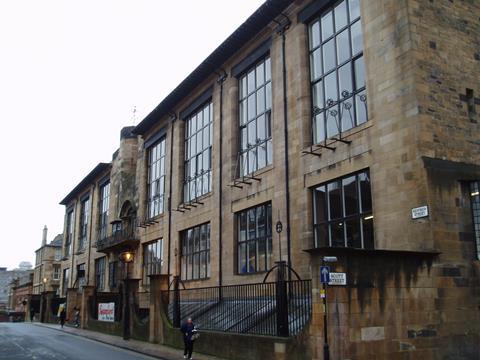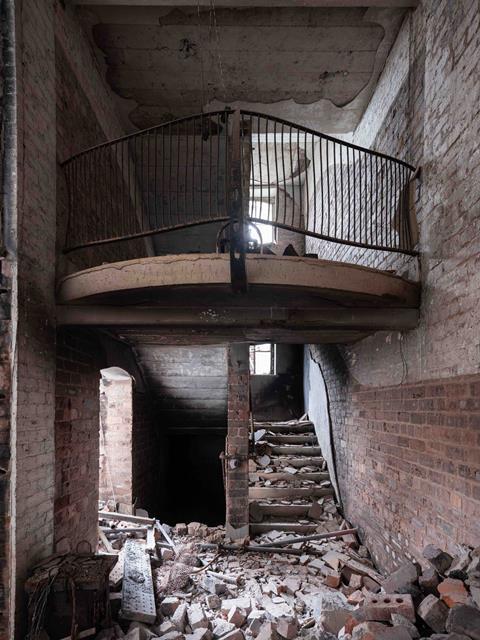Fire investigators unable to determine whether blaze was arson or accident despite three-year probe

Investigators have been unable to determine the cause of the blaze that destroyed Charles Rennie Mackintosh’s Glasgow School of Art building in 2018 during its restoration by Page\Park.
They said too much of the fabric – including the fire alarm control panel and CCTV hard drive – was consumed in the fire, the second to hit the grade A-listed building in four years.
GSA director Penny Macbeth said she and interim chair of governors Kristen Bennie “share the frustration that many will feel that the exact cause of the fire has not been identified”.
The Scottish Fire and Rescue Service (SFRS) published the findings of its detailed investigation yesterday.
Taking from the night of the fire to September 2021 – with a three-month hiatus at the start of the pandemic – it was the “most complex and resource-intensive investigation” the service had ever undertaken, said SFRS deputy chief officer Ross Haggart.
It involved the excavation and physical examination of hundreds of tonnes of fire-damaged debris and analysis of witness testimonies, CCTV and photographic footage.
The report concluded: “Despite an unprecedented and extended investigative process, sufficient evidence to support any credible origin and cause hypothesis has not been recovered from the scene or evidenced in witness testimonies or eyewitness accounts. Therefore, the origin and cause of the fire … has been recorded as ‘undetermined’.”
If further evidence emerges the investigators said they would reopen the case.
Haggart said: “We scrutinised every aspect of this fire to ensure our investigation was as robust and thorough as possible. Unfortunately almost everything within the building was severely damaged or consumed in the fire and that included any potential items of evidence that could have provided those answers.”
However the report does set out three hypotheses for how the fire could have started (see box below) and makes a number of recommendations including careful consideration of fire risks from the outset of a construction project, improved information sharing and training for all site staff. Many of the highest-profile building fires have begun during renovation works including Notre Dame and Windsor Castle. The report said: “When construction work is underway, there is little doubt that buildings are at greater risk of significant damage should a fire start.”
In June 2018, a £48m restoration project at the Mac was nearing completion after a previous fire which started in a projector in an end-of-year project, destroying Mackintosh’s celebrated library.

Although firefighters were on the scene in six minutes in 2018, 50% of the building was well alight in less than 40 minutes and at its height more than 120 were involved in the battle to extinguish the flames.
The investigators found it was likely the fire started on the east side, on or above level 4 of the building. They said an unlimited air supply fed through the duct system served to intensify the fire, promoting uncontrolled fire growth and rapid development.
Fire-stopping measures had not been introduced to the ventilation system at the time of the fire despite being identified as a factor in the spread of the 2014 fire. Directors of Page\Park told MSPs in October 2018 that this was because they planned to route the services through the ducts before stopping them up. The fire suppression system was being installed at the time of the blaze and contractor Keir admitted the fire alarm was regularly disabled during the working day.
Because passive fire safety measures were compromised during the renovations, “active fire safety measures should have been subject to a thorough programme of scheduled maintenance and testing”, said the investigators. However they were told that the contractor’s records were destroyed in the fire.

Haggart said: “Due to the nature of the ongoing restoration and construction works combined with other factors such as the air supply into the building, the fire was unfortunately able to take hold, spread and ultimately cause catastrophic damage.
“This presented a number of challenges to our investigation, namely working within a structurally dangerous site to physically examine hundreds of tonnes of debris which was up to four metres in height and heavily compacted.”
The executive summary set out the extent of the damage to the world-famous landmark in Garnethill which was completed in 1909: “The damage to the internal structure was such that almost all the combustible materials had been consumed in the fire. All timber roof structures had been completely consumed. Remaining materials, including non-combustible stonework, concrete, brick, steel and other metals suffered various degrees of fire and heat damage.
“The large timber joists that held up floors forming the levels within the building no longer existed. Surface finishes to walls and ceilings that were once timber clad, or lath and plaster, had all been consumed in the fire.
“On the walls, only bare stone and brickwork remained. The resulting fire debris from all the combustible material within the building had settled on level 2, forming a formidable and dense layer of compact material up to four metres high in some areas.”
The GSA’s Macbeth and Bennie described the report as an important milestone and said: “While the SFRS Fire Investigation Report is detailed and comprehensive, we share the frustration that many will feel that the exact cause of the fire has not been identified. Taking time to study and consider the report thoroughly, in particular the recommendations, we will now undertake and share a lessons-learnt exercise on all aspects of the restoration to inform future construction projects.”
The school remains committed to “the faithful reinstatement of the Mackintosh Building” as outlined in its report in October.
>> From the archive: If the Mac can be built once it can be built twice
HYPOTHESES
Wilful fire-raising: The scaffolding alarm system was not working properly which meant an arsonist could potentially have got into the building undetected. CCTV footage taken from the St Aloysius College sports complex captured a lone figure in the car park approximately three hours after discovery of the fire who spent more than an hour watching the fire-fighting operation. The individual’s motives were unclear and they were never traced so the scenario has not been fully dismissed. Meanwhile, on the day of the fire – graduation day – a member of the governing body received several abusive and threatening messages through social media. However the individual was interviewed by the police and ruled out.
Electrical fault: The investigators examined seven theories of ignition that could have been caused by the building’s temporary or newly installed electrics. Some were ruled out while others, including the new, yet-to-be commissioned distribution panel and the transformers powering the construction site, remain possible sources, though there is no direct evidence.
Accidental ignition (not electrical): These theories included a discarded cigarette, a chemical reaction involving a floor sander or paint stripper, or hot works undertaken by a roofing sub-contractor earlier that day. These were largely dismissed because locations did not tally with witness descriptions of where the fire appeared to start.
















No comments yet